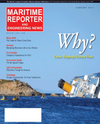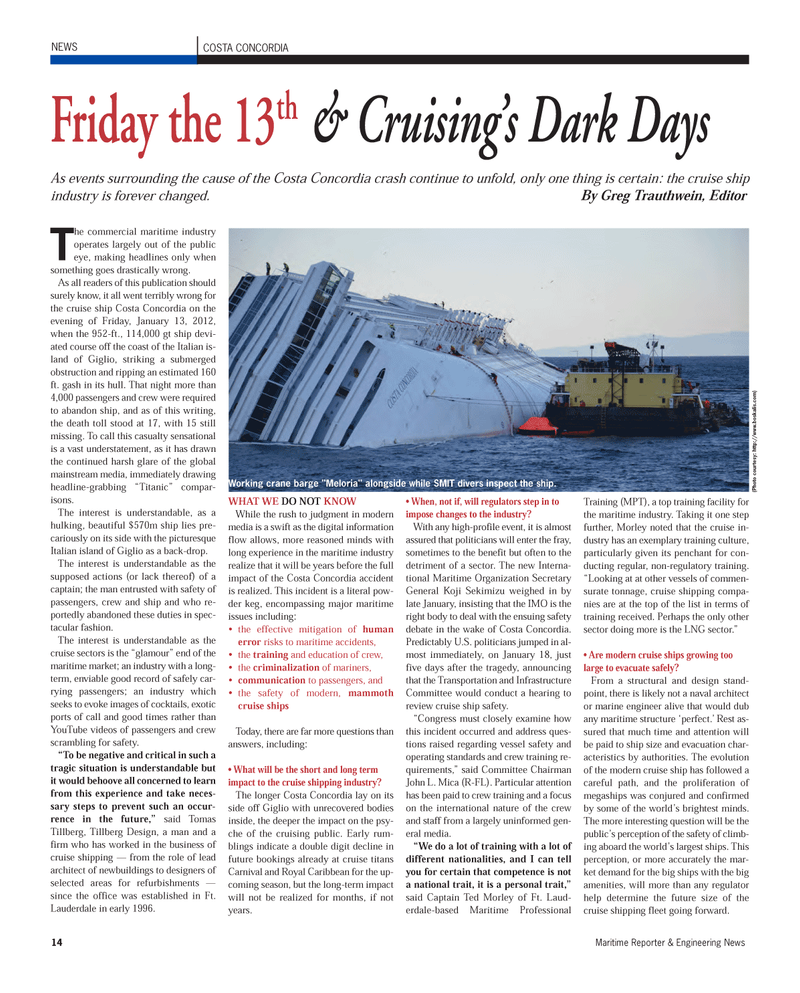
Page 14: of Maritime Reporter Magazine (February 2012)
Cruise Shipping Annual
Read this page in Pdf, Flash or Html5 edition of February 2012 Maritime Reporter Magazine
The commercial maritime industryoperates largely out of the public eye, making headlines only when something goes drastically wrong. As all readers of this publication shouldsurely know, it all went terribly wrong for the cruise ship Costa Concordia on theevening of Friday, January 13, 2012, when the 952-ft., 114,000 gt ship devi- ated course off the coast of the Italian is- land of Giglio, striking a submerged obstruction and ripping an estimated 160ft. gash in its hull. That night more than 4,000 passengers and crew were required to abandon ship, and as of this writing,the death toll stood at 17, with 15 stillmissing. To call this casualty sensational is a vast understatement, as it has drawn the continued harsh glare of the globalmainstream media, immediately drawing headline-grabbing ?Titanic? compar- isons. The interest is understandable, as ahulking, beautiful $570m ship lies pre-cariously on its side with the picturesqueItalian island of Giglio as a back-drop. The interest is understandable as thesupposed actions (or lack thereof) of acaptain; the man entrusted with safety ofpassengers, crew and ship and who re- portedly abandoned these duties in spec-tacular fashion. The interest is understandable as thecruise sectors is the ?glamour? end of themaritime market; an industry with a long- term, enviable good record of safely car- rying passengers; an industry whichseeks to evoke images of cocktails, exotic ports of call and good times rather thanYouTube videos of passengers and crew scrambling for safety. ?To be negative and critical in such a tragic situation is understandable but it would behoove all concerned to learn from this experience and take neces- sary steps to prevent such an occur- rence in the future,? said Tomas Tillberg, Tillberg Design, a man and a firm who has worked in the business of cruise shipping ? from the role of leadarchitect of newbuildings to designers of selected areas for refurbishments ?since the office was established in Ft. Lauderdale in early 1996. WHAT WE DO NOT KNOW While the rush to judgment in modernmedia is a swift as the digital informationflow allows, more reasoned minds with long experience in the maritime industry realize that it will be years before the fullimpact of the Costa Concordia accidentis realized. This incident is a literal pow- der keg, encompassing major maritime issues including: the effective mitigation of humanerror risks to maritime accidents,the trainingand education of crew, the criminalizationof mariners,communicationto passengers, andthe safety of modern, mammothcruise shipsToday, there are far more questions than answers, including: What will be the short and long term impact to the cruise shipping industry?The longer Costa Concordia lay on itsside off Giglio with unrecovered bodies inside, the deeper the impact on the psy-che of the cruising public. Early rum-blings indicate a double digit decline infuture bookings already at cruise titansCarnival and Royal Caribbean for the up- coming season, but the long-term impact will not be realized for months, if notyears. When, not if, will regulators step in to impose changes to the industry?With any high-profile event, it is almost assured that politicians will enter the fray, sometimes to the benefit but often to the detriment of a sector. The new Interna- tional Maritime Organization Secretary General Koji Sekimizu weighed in by late January, insisting that the IMO is the right body to deal with the ensuing safetydebate in the wake of Costa Concordia. Predictably U.S. politicians jumped in al-most immediately, on January 18, just five days after the tragedy, announcing that the Transportation and Infrastructure Committee would conduct a hearing to review cruise ship safety. ?Congress must closely examine how this incident occurred and address ques-tions raised regarding vessel safety and operating standards and crew training re- quirements,? said Committee Chairman John L. Mica (R-FL). Particular attention has been paid to crew training and a focus on the international nature of the crew and staff from a largely uninformed gen- eral media.?We do a lot of training with a lot of different nationalities, and I can tell you for certain that competence is not a national trait, it is a personal trait,? said Captain Ted Morley of Ft. Laud- erdale-based Maritime ProfessionalTraining (MPT), a top training facility for the maritime industry. Taking it one step further, Morley noted that the cruise in- dustry has an exemplary training culture, particularly given its penchant for con- ducting regular, non-regulatory training. ?Looking at at other vessels of commen- surate tonnage, cruise shipping compa-nies are at the top of the list in terms oftraining received. Perhaps the only other sector doing more is the LNG sector.? Are modern cruise ships growing too large to evacuate safely? From a structural and design stand-point, there is likely not a naval architect or marine engineer alive that would dub any maritime structure ?perfect.? Rest as- sured that much time and attention willbe paid to ship size and evacuation char- acteristics by authorities. The evolution of the modern cruise ship has followed a careful path, and the proliferation ofmegaships was conjured and confirmed by some of the world?s brightest minds. The more interesting question will be thepublic?s perception of the safety of climb- ing aboard the world?s largest ships. This perception, or more accurately the mar- ket demand for the big ships with the big amenities, will more than any regulator help determine the future size of thecruise shipping fleet going forward. 14Maritime Reporter & Engineering News NEWSCOSTA CONCORDIA Working crane barge "Meloria" alongside while SMIT divers inspect the ship. Friday the 13 th&Cruising?s Dark Days As events surrounding the cause of the Costa Concordia crash continue to unfold, only one thing is certain: the cruise ship industry is forever changed. By Greg Trauthwein, Editor (Photo courtesy: http://www.boskalis.com) MR Feb.12 # 2 (10-17):MR Template 2/7/2012 2:11 PM Page 14

 13
13

 15
15
